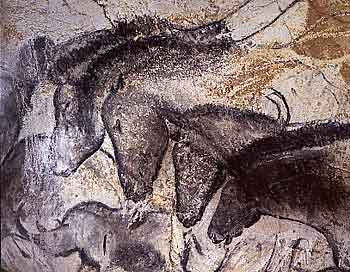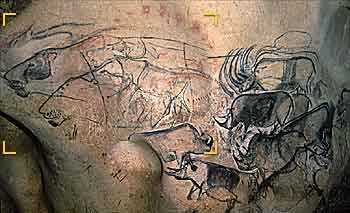


What makes us human?
Anatomically modern humans evolved some 130,000 years ago, but it wasn't until about 32,000 years ago that an explosion of art and culture appears in the archaeological record. Take a look at the images above -- they were inscribed on the walls of a cave in Chauvet, France 32,000 BP (Before Present). Can anyone look at these astonishing images and not feel an immediate connection -- not only to the humans that drew them in ancient times, but to all of humanity?
The hand, at top, is the product of one of the first spray-painters. Red paint was held in the mouth, the hand placed on the rock, and then the paint spat in a spray all around the hand to leave an unmistakably personal image. Given the various sizes and shapes of the hands depicted at Chauvet, anthropologists have concluded that women and adolescents probably participated in this as well. But why? Looking at this, we recognize the impulse to draw as one we all share. Was the hand a personal statement by an individual, what we would consider an artist, implanting his individual stamp on the cave? Or did it have some greater metaphorical meaning? Was it part of a ritual, a magical invocation, a shamanistic tradition? The latter explanation is lately the most popular amongst experts in cave art, but part of the allure of these images is their mystery. Sometimes the cave artists put red paint on the palms of their hands, then stamped multiple red dots in a pattern we can now recognize as a rhinoceros, or an antelope. These pointilists predate Seurat by over 30,000 years.
The second image is of a horse. Yes, it's probably just one horse. Our modern eyes see this superposition as an attempt to depict depth, but anthropolists have begun to think that this is in fact the movement of a horse through time. The image at lower right is the horse as youngster, growing older with each successive depiction. A similar idea occurs in the third photo with the rhinocerous on the middle right. It looks as if the artist may have drawn him and his horn many times, perhaps trying to get it right. But in fact, this is no drawn-over sketch. The artist decided to show the rhino's movement of his horn, perhaps scraping it against a tree or battling some other, undrawn beast.
Also remarkable is the plentiful depiction of predators like the lions shown in the third picture. Before the discovery of the Chauvet Cave in 1994, few dangerous animals like this were known to have been inscribed. From archaeological evidence, we know that early humans did not hunt lions (no feline bones found amongst their hearths or used for tools or artifacts), so this panel of huge cats came as quite a surprise to the experts who first viewed it. These lions have helped trample the popular notion that these cave paintings were intended for use as some sort of magical invocation for the hunt. In fact, few hunting scenes are shown in cave paintings all over the world. And in prehistoric Europe, from 32,000BP to 12,000BP, few human figures of any kind have been found. The closest we get to them are a handful of so-called "Venus" figurines (women, often pregnant), depictions of male and female genitalia, and the hands, as in the first photo here.
So why were these paintings made? Did the painters of that era have a concept of "art" such as we understand it? Studies of more so-called primitive peoples, like the Inuit in Alaska and the aborigines of Australia, suggest that we cannot impose our own modern reasons for image-making upon these ancient drawings. The Inuit, for example, can recognize an image no matter how it's oriented -- they have no concept of it being "right side up." When they draw, they often depict events happening all at once -- events that, in real life, occur in succession. Space and time, as they see it, are not compartmentalized, linear, or separate. How different, then must've been the thinking of the artists of Chauvet and more recent caves like Lascaux and Altamira (around 15,000 BP) even from the Inuit and aborigines.
And yet -- how human these paintings are. Whatever their pupose, we can recognize in them immediately our common heritage. The desire for image, story, and metaphor is one we all know. Although homo sapiens were anatomically modern long before Chauvet, it is here, I think, that true humanity begins.
Visit the cave at http://www.culture.gouv.fr/culture/arcnat/chauvet/en/
No comments:
Post a Comment